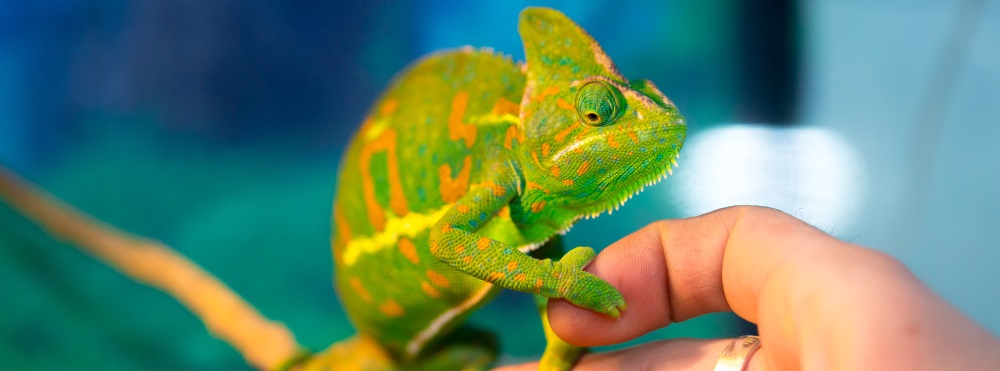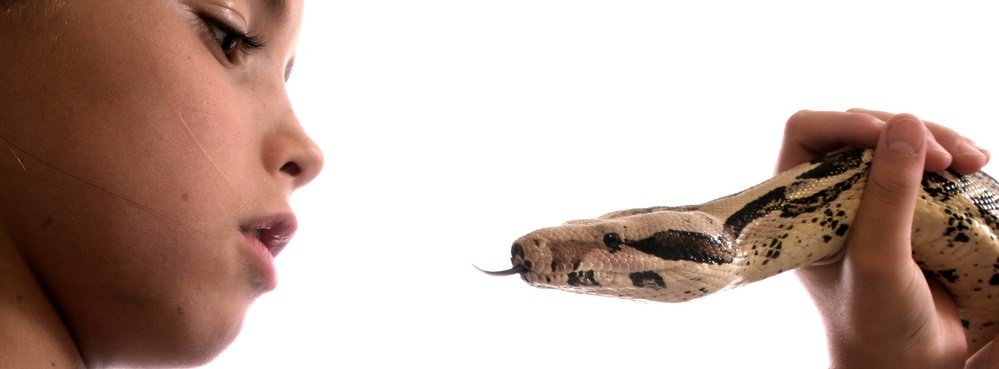Can Betadine Discolor Dragon Skin
How to Treat Scale Rot on Reptiles
In comparison with other household pets, reptiles seem similar categorically low-maintenance animals. Merely their hard exterior doesn't protect them from everything—they have scales, not an impenetrable suit of armor.
Scale rot is one of the more common reptile ailments. Both curing and preventing it rely on one main factor: cleaning—the enclosure, and the affected area. Keep reading to learn how to treat scale rot, including which products to use for optimal results.
What is Scale Rot?
Scale rot is as a catch-all term for any trouble with your pet reptile's scales or skin, including:
- Blister disease (vesicular dermatitis)
- Ulcerative dermatitis
- Bacterial abscesses
- Secondary infections as a result of burns or abrasions
What Causes Scale Rot?
Curing and preventing scale rot relies partly on identifying what caused information technology. The chief causes are somewhat interconnected, so information technology may be a combination of these factors:
- Unsanitary living environment – Caring for a living creature is hard work, whether information technology's a pet ophidian or a newborn infant. Appropriate reptile husbandry includes adequately cleaning their enclosure on a regular basis. Y'all wouldn't permit your child sleep in a soiled crib, and so don't allow your pet ophidian slither around in a dirty terrarium.
- Improper habitat regulation – The temperature and humidity of your pet's enclosure play a key role in scale rot. Often, when their habitat is too wet and common cold, the substrate (bedding) never fully dries, creating the perfect breeding ground for bacteria and fungi that often pb to calibration rot—perfect for the bacteria, non so perfect for your pet.
- Deficiency of vitamins A or C – This is less commonly cited every bit a trigger for scale rot but tin contribute to its development. If the living conditions are optimal, this may mean the reptile lacks sufficient nutrients.
How to Identity Calibration Rot
Calibration rot is similar to wood rot in that it can breed in ane damp area and spread throughout the structure—or creature, in this case. The longer it goes unchecked, the more than likely information technology is to create a larger problem. Check regularly for early signs of scale rot:
- Skin or scales are cracked and crusty
- Raised or bloated scales
- Red, dark-brown, or otherwise nighttime discolored pare, peculiarly most the tail or on the abdomen
- Loss of appetite
When to Take Your Pet to the Vet
Scale rot appears to be a surface-level issue, so many pet owners treat it every bit such. Nevertheless, in many cases, there may exist underlying weather condition and more than severe complications if left untreated.
In anything other than the mildest cases of scale rot, you should consult a veterinarian. There are more severe signs that warrant immediate medical attention, in addition to the early symptoms mentioned above:
- Blisters filled with fluid, either clear or blood-tinged
- Abscesses, or ulcers after they've shed their skin
The best advice is to consult a herpetologist (or herp vet) when you feel uncertain almost treating the event properly. There'south nothing wrong with admitting you need help—your reptile would thank you, if only they could talk.
The vet may administer antibody injections and, in a severe case, sedate the animal to perform a full-scale (no pun intended) removal and cleaning of the infected areas.
Getting Rid of Scale Rot
If you've identified this to be a mild case, you can treat your reptile's scale rot at home.
#1 Make clean and Sterilize the Enclosure
Living conditions accept a pregnant touch on your reptile's health, especially when it comes to scale rot handling. Thoroughly cleaning the enclosure volition meliorate healing and forbid a secondary infection.
- Transport to a temporary enclosure – Remove your reptile from their usual home and identify them in a curt-term lodging—similar a brief stint in a luxury hotel while your apartment is being fumigated. Yous could use a large tote or container, as long as the surround is make clean and dry, and at the correct temperature and humidity level. You tin even add a layer of dry substrate to proceed them comfy.
- Remove soiled substances – Throw out all dispensable substrate and thoroughly clean whatsoever dishes, bowls, and accessories in hot, soapy water. Anything fabricated of a porous material, similar wood, should exist tending of also in this case.
- Clean the cage – Once the cage is empty of all creatures, contaminants, and equipment, make clean the entire surface with hot water and dishwashing liquid, and so rinse thoroughly. All organic compounds must be removed entirely before moving onto the next pace.
- Disinfect everything – The disinfectant y'all purchase should be strong plenty to impale harmful bacteria and fungi, merely rubber enough non to harm your pet reptile. There are plenty of brands on the market, simply you can too create a solution with household bleach, diluted with almost one gallon of water for every half-cup of bleach. The disinfectant takes about ten minutes to thoroughly sanitize the hardware. Rinse thoroughly.
- Expect for the enclosure to dry – To avoid reintroducing the trouble you just eradicated, look until everything has completely dried before moving your pet back to its rightful home. Otherwise, you may end upward with boosted mold or bacteria.
#2 Suit the Temperature and Humidity
Your scaly sidekick requires a sure humidity level, simply too much tin can pb to the evolution and prolongation of scale rot and other bacterial infections. Similarly, they necessitate a specific temperature.
How Boiling Should It Exist?
There's no magic number when it comes to how humid their enclosure should be. The perfect residuum is entirely dependent on the species, plus snakes crave increased humidity as they shed their outer layer, so information technology may change throughout the year.
You'll know the enclosure is too humid when the substrate never fully dries between mistings, or at all. If their bedding is consistently clammy, leaner and fungi are likely to abound in it and eventually touch your pet.
What'southward the Right Temperature?
Reptiles aren't able to internally regulate their body temperature the same manner humans and other mammals can. Instead, they depend on their surroundings: when they're cold, they savor in the dominicus, and when they're hot, they absurd off in the shade—they live a unproblematic lifestyle.
But reptiles living in captivity are hardly able to do this. They're subjected to the temperature of the enclosure, aside from the small-scale variation in heat caused past placing a basking lamp at one end of the cage. They tin can motion away from or towards it, just they've lost the ability to self-regulate in the same way. This is why it's so important to maintain the perfect temperature.
The number varies for each species and season, merely a standard temperature for reptiles is between 70 and 85°F , with warmer areas for basking.
If the enclosure isn't warm plenty, this tin contribute to the consistently damp substrate. Raising the temperature slightly tin decrease the risk of mold and bacteria.
#three Clean the Infected Pare
Now that the environment is perfectly suitable for your animal's homecoming, information technology's time to address the issue first-manus. With mild instances of scale rot, a topical disinfectant—in conjunction with the essential environmental changes listed above—can be enough to alleviate your reptile of their scale rot.
There are two chief steps involved in a thorough cleaning procedure:
- Betadine bath – These are especially important for treating any blisters and tin can be useful no thing how mild or severe the scale rot is. Fill a large saucepan or container with lukewarm h2o, enough for the reptile to fully submerge without drowning. Add together one role betadine for every ten parts of water, place your reptile within, and then comprehend with a lid yous've poked holes in. Allow them soak for half an hour, then dry out them off with a towel. This tin can assistance mitigate bacterial infection.
- Antimicrobial spray – Once you've soaked and dried the area, utilise an antibiotic spray. Vetericyn'south non-toxic, antimicrobial spray is a rubber way to clean and moisturize any open wounds and initiate the healing procedure. Spray the affected areas three to four times daily for the best results.
It'southward crucial to maintain consistent treatment and proceed the enclosure every bit make clean as possible.
 Preventing Scale Rot
Preventing Scale Rot
The easiest way to deal with scale rot is by never having to deal with it in the first place! Preventing calibration rot requires diligent reptile care, starting with a few straightforward steps:
- Daily cleaning – Clean up any spilled liquids, shed skin, or eliminated waste product at least one time a twenty-four hour period. Again, if you wouldn't allow your newborn infant live in those conditions, you lot shouldn't let your reptile pal, either.
- Weekly cleaning – One time every week or two, you should perform a more than in-depth cleaning, following the sterilization procedure outlined earlier.
- Sturdy h2o basin – This may seem deceptively simple, but a sturdy basin will prevent spillage that leads to damp living conditions and increased bacteria.
- Optimal environment – Maintain the ideal humidity and temperature at all times. Check to brand sure the substrate is drying correctly; if not, consider raising the temperature slightly or lowering the humidity. Y'all can reduce the humidity by increasing the ventilation or scaling back on the regular mistings.
Get Rid of Calibration Rot For Good
Once you lot've dealt with scale rot in your pet, you'll desire to practise everything in your ability to prevent it from happening once more. The tips outlined above are a expert commencement, but things happen—animals are uncontrollable creatures that spill things, make messes, and yes, regularly eliminate waste material.
You can't command them, only you can gear up for them!
By stocking upward on cleaning products, betadine, and a multi-purpose antimicrobial handling, you'll exist gear up for whatever problem they slither into adjacent.
 Reviewed past Dan Richardson, Veterinary
Reviewed past Dan Richardson, Veterinary
Dan Richardson has been a practicing veterinarian for over 10 years. He specializes in surgery and orthopedics. Dan is originally from rural western Nevada and attended the University of Idaho for undergraduate written report and Oregon Land University for Veterinary School. The Richardson Family enjoys camping and spending time on the water line-fishing, paddle boarding, or digging their feet in the sand somewhere warm.
Sources:
- Ophidian Tracks. Scale Rot in Snakes . https://www.snaketracks.com/scale-rot-in-snakes/
- Reptiles Magazine. Identify And Treat Mouth, Beat And Scale Rot in Reptiles. https://world wide web.reptilesmagazine.com/place-and-treat-oral fissure-shell-and-scale-rot-in-reptiles/
- Snakes for Pets. How To Get Rid of Calibration Rot On A Snake. https://www.snakesforpets.com/how-to-get-rid-of-calibration-rot-on-a-snake/
- PetCo. Your Reptile'due south Ecology Needs. https://world wide web.petco.com/content/petco/PetcoStore/en_US/pet-services/resource-center/new-pet/reptile-remodeling-proper-habitat-setup.html
- PetCoach. How to Clean and Disinfect Reptile Cages. https://world wide web.petcoach.co/article/habitats-cleaning-and-disinfecting-reptile-cages/
Source: https://vetericyn.com/blog/how-to-treat-scale-rot-on-reptiles/
Posted by: langfordcounce.blogspot.com



0 Response to "Can Betadine Discolor Dragon Skin"
Post a Comment